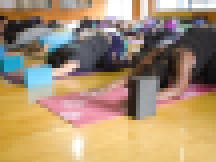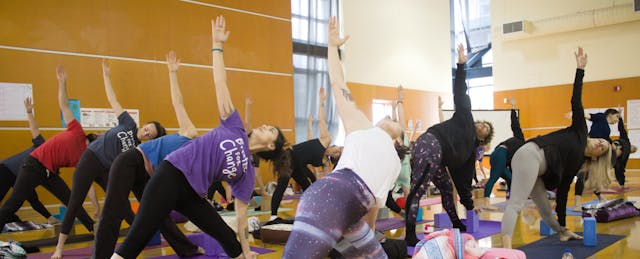SAN FRANCISCO — Kimberley Rose knew that breathing exercises could help kids calm down. Yet she never would have incorporated them into her classroom if she hadn’t experienced the power of these exercises herself.
Rose picked up a couple of breathing strategies as a student in Breathe For Change, a 200-hour wellness and yoga teacher certification program for educators. She spent many of her weekends this past fall at an elementary school in San Francisco’s Tenderloin district, alongside 83 other peers, including fellow classroom teachers and other educators. Together, they learned yoga and meditation techniques, along with philosophy, anatomy and social-emotional learning strategies.
Breathe For Change was founded by former pre-K teacher Ilana Nankin to improve the well-being of educators. When Nankin was teaching in San Francisco, she felt stressed, overwhelmed and overworked—classic signs of job burnout. But she was able to improve her well-being through yoga, and shared some of those practices with her students. As a result, she said she saw her students transform both emotionally and academically.
In 2012, Nankin moved from San Francisco to Wisconsin to pursue a Ph.D. in curriculum and instruction. As part of her doctorate, she taught courses to pre-service educators through a social justice lens. For her dissertation, she focused on how teachers who had taken her classes translated the ideals they’d picked up as they embarked on their first year of teaching. But what she discovered was that, across the board, they were already burned out. They “did not have the tools to take care of themselves,” she said, “let alone the tools to support their kids.”

At the same time, Nankin’s current adult students learned she was also a yoga teacher. They rented out space in the student union for her to teach them yoga every week. Nankin explained that her students started using the yoga, wellness and social-emotional practices she was teaching them with their own students. Those pre-service teachers told Nankin they were seeing their young students benefit from the practices.
In 2015, she started Breathe For Change. It has since trained about 2,500 people, and currently operates in eleven cities. It plans to expand to three more cities next summer.
Unsurprisingly, what draws some educators to the program is the desire to alleviate the symptoms of their burnout. Rose, who teaches first and second grade special education at Los Cerritos Elementary School in South San Francisco, felt like she was “was drowning.” She knew that unless she learned how to deal with her stressors, she wasn’t going to make it as a special education teacher.

Desiree Choy also needed a change. A second grade teacher at Monterey Bay Charter School, located about two and a half hours down the coast from San Francisco, Choy had reached a point in her roughly eight-year teaching career where she felt burned out. The burnout, she explains, was caused by stress—from a combination of her packed workload and a “neverending to do list.”
Being a classroom teacher, she said, can be emotionally and physically demanding. She was exploring ways she could leave the classroom, but still remain in education. But when she learned about Breathe For Change, she decided to apply. She was especially interested in the social-emotional part of the company’s curriculum, and thought the program could help her manage her own personal and professional life.
“I wasn’t really sure where this would go or what it would do, but I was just drawn to it,” Choy said.

Rose and Choy are far from the only teachers who have felt overwhelmed. According to a 2014 report by the Alliance For Excellent Education, a national policy and advocacy organization, roughly half a million U.S. teachers step away from or altogether leave the profession each year. The National Center for Education Statistics states that about 51 percent of public school teachers who left teaching in 2012-2013 said that their workload was more manageable in their new position compared with the classroom. Of those who left public school, 53 percent said their general work conditions were better.
“Teachers, they’re doing such critically important work, and it’s such hard work,” Nankin said. “There’s a lot of stress that comes with it.”
Nankin designed the program so that teachers learn more than yoga. They also learn how they can be more mindful, communicative, inclusive and collaborative. She said that if educators aren’t embodying the social-emotional learning practices they’re teaching to students, then they won’t get desired outcomes. Teachers, she thinks, can eventually become more responsive, as opposed to reactive, when interacting with students and colleagues.
“We see [Breathe For Change] as a social-emotional training for educators,” Nankin said. “And then from them living and understanding and practicing yoga, meditation, mindfulness, different ways of effective communication and other wellness practices, they’re so much more equipped to be able to teach that to kids.”

Choy said that she’s excited to be in the classroom, and share what she’s learned with her students. She said her own students are now using nonviolent communication with each other, and practice yoga, meditation and mindfulness. She’s also made efforts to be more inclusionary in her classroom.
Choy wants her coworkers to practice self-care too. She’s shared some of what she’s learned with them in faculty workshops, and has asked her school to designate a part of teachers’ annual professional development funds to focus on wellness.
“I think it’s so vital to keep teachers in the profession,” Choy said. “We’re in a massive teacher shortage. Each year there’s this scramble to try to find enough teachers, and it’s because nobody wants to go into it because it’s so demanding.”
Rose, the special education teacher, found the breathing strategies she learned at her Breathe For Change training effective. And now she is working on getting her students to breathe too. She understands how much breathing can help people regain a sense of calm, and uses a GoNoodle video on “Bee Breath,” which encourages humming while you exhale to focus the mind, with her kids. She’s also teaching them how better manage their emotions.
“Honestly, when I did it, I didn’t think it would work,” Rose said about introducing breathing exercises to her class. “But there have been two kids who I never, ever thought would do it who are doing it. These kids were throwing chairs and biting and pulling hair and so forth. I never thought I could get them to calm down with Bee Breath.”


